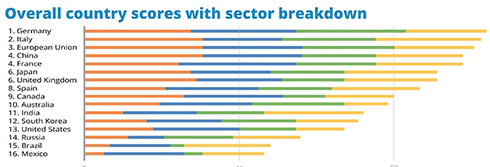
|
Published: 28 July 2014
Australia ranks 10th on international energy efficiency scorecard
Australia comes 10th in an energy efficiency ranking of 16 of the world’s major economies. Germany comes 1st, followed by Italy, the European Union as a whole, China, and France, according to the 2014 International Energy Efficiency Scorecard published this month by the nonprofit American Council for an Energy-Efficient Economy (ACEEE).

|
|
Country scores. The colour codes of the sector breakdowns are, orange: national efforts, blue: buildings, yellow: transportation, green: industry. Credit:
ACEE
|
Now in its second edition, the ACEEE report finds that, while some countries are still significantly outperforming others, there are substantial opportunities for improved energy efficiency in all economies analysed.
The 16 economies represent over 81 percent of global gross domestic product and 71 percent of global energy consumption.
On a scale of 100 possible points in 31 categories, the nations were ranked by ACEEE as follows: (1) Germany; (2) Italy; (3) the European Union; (tied for 4) China; (tied for 4) France; (tied for 6) Japan; (tied for 6) United Kingdom; (8) Spain; (9) Canada; (10) Australia; (11) India; (12) South Korea; (13) United States; (14) Russia; (15) Brazil; and (16) Mexico.
ACEEE divided the 31 metrics across four groupings: those that track cross-cutting aspects of energy use at the national level, as well as the three sectors primarily responsible for energy consumption in an economically developed country – buildings, industry, and transportation. The top scorers in each grouping are: EU, France and Italy (three way tie for national efforts); China (buildings); Germany (industry); and Italy (transportation).
‘Germany is a prime example of a nation that has made energy efficiency a top priority,’ says Steven Nadel, ACEE’s Executive Director.
‘The United States, long considered an innovative and competitive world leader, has progressed slowly and has made limited progress since our last report, even as Germany, Italy, China, and other nations surge ahead.’
The ACEEE ranking system looks at both ‘policy metrics’ and ‘performance metrics’ to measure a country’s overall energy efficiency. Examples of ‘policy metrics’ include the presence of a national energy savings target, fuel economy standards for vehicles, and energy efficiency standards for appliances. ‘Performance metrics’ measure energy use and provide quantifiable results. Examples include average miles per gallon of on-road passenger vehicles and energy consumed per square foot of floor space in residential buildings.
In addition to expanding the list of global economies included in the ranking, there have been other changes made since the last International Energy Efficiency Scorecard report was published in 2012. New metrics include water efficiency policy, agricultural efficiency, building retrofit policies, heavy-duty fuel efficiency standards, and investment in energy efficiency by the private sector.
Founded in 1980 by leading researchers in the energy field, ACEEE is a nonprofit organisation that acts as a catalyst to advance energy efficiency policies, programs, technologies, investments, and behaviours.
Source: ACEE



